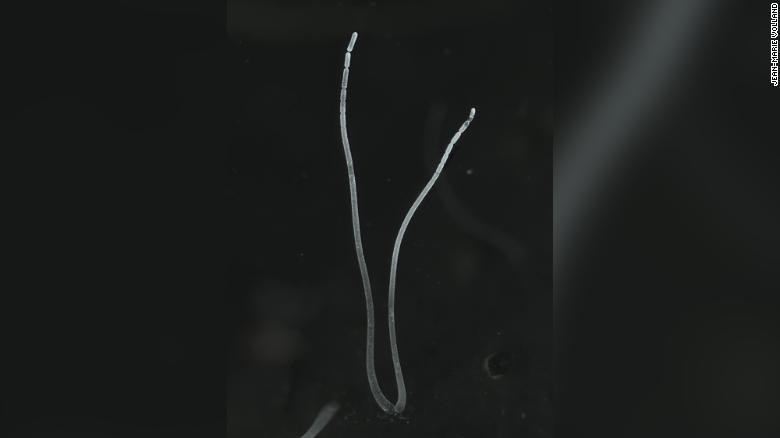
(CNN) – These are bacteria like you’ve never seen before — likely because, until now, all known bacteria could only be seen using a powerful compound microscope.
A newly discovered bacterium that is large enough to be visible to the naked eye, and resembles the shape and size of an eyelash, has been found in Guadeloupe in the Lesser Antilles, according to a study published Thursday in the journal Science.
Thiomargarita magnifica — a reference to its exceptional size — has an average cell length greater than 9,000 micrometers, which is nearly 1 centimeter (0.4 inches) in length. Cells of most bacterial species are around 2 micrometers in length, although larger ones can reach 750 micrometers.
T. magnifica can grow up to 2 centimeters long, according to study coauthor Jean-Marie Volland, a marine biologist and scientist at California’s Laboratory for Research in Complex Systems, and an affiliate at the US Department of Energy Joint Genome Institute.
“To understand how gigantic that is for a bacterium, it is the same as if we were to find a human as tall as Mount Everest,” he told CNN Wednesday.
More than 625,000 E. coli bacteria could fit on the surface of a single T. magnifica. However, despite its size, the bacterium has a “notably pristine” surface, devoid of the bacteria that live on the surface of plants and living animals, according to the study.
How does it sustain its size?
It was previously thought that bacteria could not grow to a size visible to the naked eye because of how they interact with their environment and produce energy.
But T. magnifica has an extended network of membranes that can produce energy so that it’s not relying only on the surface of the bacterium to absorb nutrients through its cell. Volland was able to visualize and observe the giant cells in 3D with the help of hard X-ray tomography, confocal laser scanning microscopy and transmission electron microscopy, according to a news release.
Unlike most bacteria, which have genetic material freely floating inside their single cell, a T. magnifica cell has its DNA contained in small sacks that have a membrane, called pepins.
“This was a very interesting discovery that opens a lot of new questions because it is not something that is classically observed in bacteria. It is actually a characteristic of more complex cells, the type of cells that constitute our bodies or animals and plants,” Volland said. “We want to understand what are those pepins and what exactly they do, and if they play a role in the evolution of gigantism for these bacteria, for instance.”
T. magnifica was first discovered growing as thin white filaments on the surfaces of decaying mangrove leaves in shallow tropical marine mangrove swamps in Guadeloupe, according to the study.
These giant bacteria grow on sediments at the bottom of the sulfurous waters, where they harness the chemical energy of the sulfur and use oxygen from the surrounding water to produce sugars, according to Volland. T. magnifica can also make food from carbon dioxide.
It has been suggested that by being much larger than the average bacterium, a T. magnifica cell could be better at accessing both the oxygen and sulfur in their environment at the same time, according to Volland.
It’s also possible that the largeness of T. magnifica cells in comparison with the other microbes in the bacterial population means that they do not need to worry about being eaten by predators.
A microbial ‘black box’
Tanja Woyke, a senior scientist at Lawrence Berkeley National Laboratory in California, thinks that it’s likely that the giant bacteria, or related species, could be found in other mangroves around the world.
“It always strikes me how little we know about the microbial world and how much is out there,” she told CNN Wednesday, adding that the microbial world “is still a black box.” Woyke, who leads the US Department of Energy Joint Genome Institute’s Microbial Genomics Program, is one of the study’s senior authors.
“Confirmation bias related to viral size prevented the discovery of giant viruses for more than a century,” concluded the study. “The discovery of Ca. T. magnifica suggests that large and more complex bacteria may be hiding in plain sight.”
“Only because we haven’t seen it yet, doesn’t mean that it doesn’t exist,” Woyke added.




